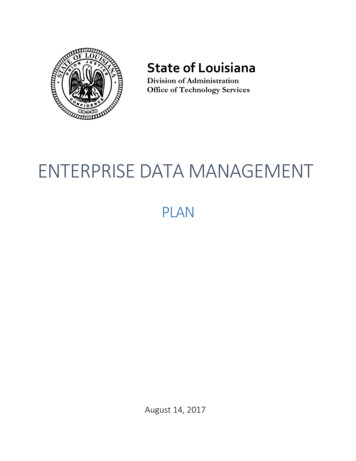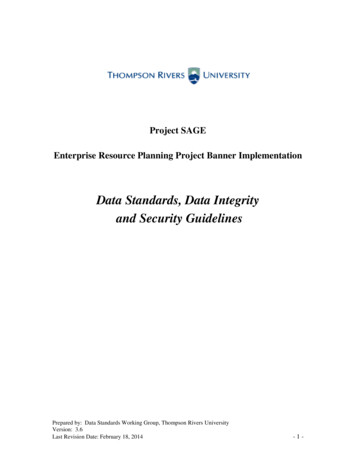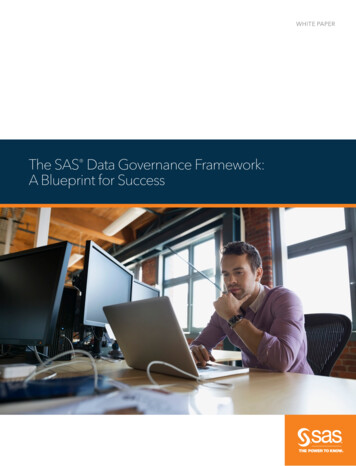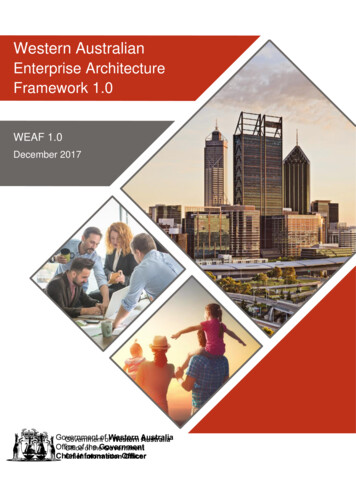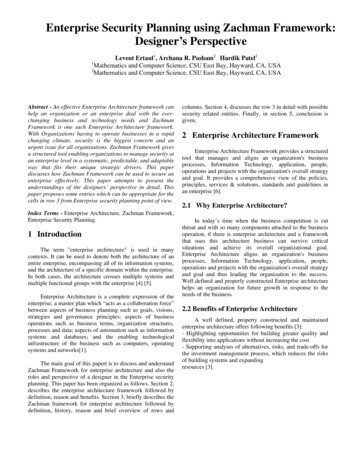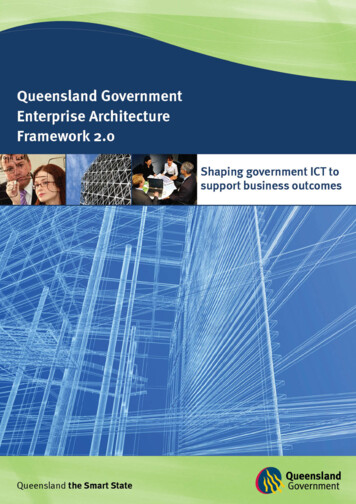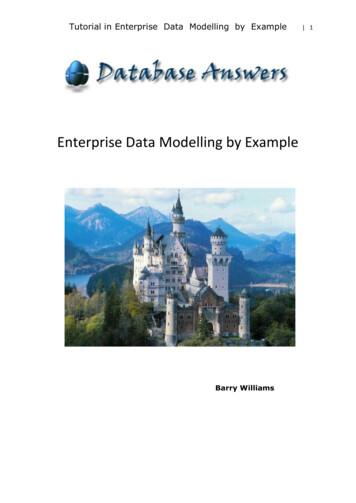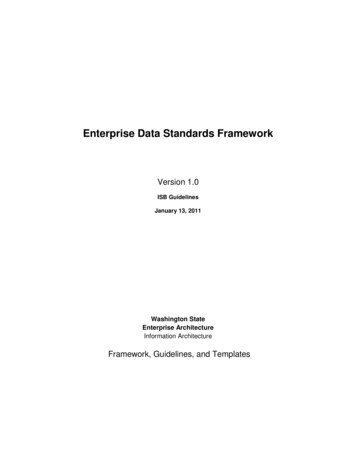
Transcription
Enterprise Data Standards FrameworkVersion 1.0ISB GuidelinesJanuary 13, 2011Washington StateEnterprise ArchitectureInformation ArchitectureFramework, Guidelines, and Templates
Washington State Enterprise Architecture – Information ArchitectureEnterprise Data Standards FrameworkJanuary 13, 2011ISB Guidelines - Version 1.0Table of Contents121. Purpose332. Description343. Enterprise Data Standards Framework453.1. Identify and Confirm Business Driver463.2. Involve Stakeholders573.3. Set Data Standard583.4. Develop Implementation Plans793.5. Monitor Implementation8104. Glossary8115. References9126. Document Context9137. Document History9148. Appendix A – Roles & Responsibilities Matrix10159. Appendix B - Process Flow Chart111610.Appendix C – Implementation Plan Template1718Page 2 of 1212
Washington State Enterprise Architecture – Information ArchitectureEnterprise Data Standards Framework192021222324January 13, 2011ISB Guidelines - Version 1.01. PurposeThe Data Standards Framework is designed to help agencies develop state enterprise data standards. Itincludes steps and templates to help document value proposition, obtain sponsorship, engagestakeholders, and drive new data standards to completion. Stakeholder participation is key.The Framework is designed to help agencies succeed. It provides details, yet is designed for flexibilityand agility. Tasks and steps may be combined where possible for efficiency.26This document, related templates, processes and websites are expected to evolve as more enterprisedata standards are developed and agencies continue to collaborate and coordinate.272. Description282930This document defines the Framework, with guidelines and processes, to help state enterprise lines ofbusiness and agencies establish Tier One enterprise data standards. Glossary entries and Referencesnoted in BOLD.31The Framework provides a step-by-step Step 1 - Identify and confirm business drivers;Step 2 - Involve stakeholders;Step 3 - Set data standards;Step 4 - Develop implementation plans; andStep 5 - Monitor implementationAppendicesAppendix A - Roles and Responsibilities Matrix - who should participate.Appendix B - Process Flow Chart - who does what, and when and how the steps fit together.Appendix C - Implementation Plan Template - expected budgets/costs, schedules, roles, migrationstrategies, and more.Related itecture.aspxData Standards Business Case TemplateData Standards with Data Dictionary TemplateKey TermData Standard – Documented agreement on the format and definition of common data. Establishedconsistent specifications for data elements, such as the name of the data standard, definition, fieldlength, executive data steward, and other components.State enterprise data standards may be specific to a line of business such as Finance, Supply ChainManagement, or span business functional areas (e.g. name, address.)Page 3 of 12
Washington State Enterprise Architecture – Information ArchitectureEnterprise Data Standards Framework523. Enterprise Data Standards Framework533.1. Identify and Confirm Business Driver5455565758January 13, 2011ISB Guidelines - Version 1.0A business case helps identify and communicate the value proposition for establishing enterprise datastandards. Not all data or information has the same associated value or risks.Data standards proposals can be initiated various ways such as: Governor or legislative direction,enterprise goals and strategies, Information Services Board, committees, groups, agencies, businesses,or individuals.60Once initiated a Primary Steward is needed to drive to business case and proposed data standards tocompletion using the Data Standards Framework process and templates.613.1.1. Identify Business Need and Begin to Populate Business Case (Initiator/Primary Steward)5962636465Check for existing state data standards on the state’s data website (aka registry) and AccessWashington search tool before starting business case.Check federal, state; and industry data standards for efficiency and interoperability. Include sites likeNIEM.gov in your search.67Identify and contact potential primary steward. Some data may have clear owners, while other mayrequire additional executive sponsors to support project.68Download business case template from: aspx6970Start to draft Business Case and communicate with potential executive sponsors, data stewards, andstakeholders.71Note and begin to address any key issues or decisions.66727374757677787980818283843.1.2. Review Business Case (State EA Program)Review draft business case with EA Program to help verify proposal is a likely candidate for Tier Oneenterprise data standards.EA Program should help Primary Steward identify necessary steps, potential stakeholders, and helpenable business case to move forward.3.1.3. Possible Tier One Standard? (Primary Steward/State EA Program)Check state Data Standards website for existing or related standards, subject area, and PrimarySteward/business owner.Decide if proposed standards qualify as Tier One using ISB definitions of tiers and EA CommitteePrinciples; identify if business case includes enough information to proceed.If no, contact Initiator with findings or request more information to make a decision. If yes, send initialdraft business case to Primary Steward.3.1.4. Identify Executive Sponsors. (Primary Steward)86If Executive Sponsors have not yet been identified, Primary Steward should identify appropriatesponsors to help review business case.87Inform Executive Sponsors when business case requires their review.85883.1.5. Review Business Case w/Dependencies and Success Factors (Executive Sponsors)Page 4 of 12
Washington State Enterprise Architecture – Information ArchitectureEnterprise Data Standards Framework899091929394January 13, 2011ISB Guidelines - Version 1.0Review business case to determine whether proposal is sound and confirm sufficient executivesupport to continue.Discuss possible system dependencies and associated risks. Determine if the data standards alonewill solve the business problem or whether there are other steps required such as the development ofan information system.3.1.6. Approve Business Case to Move Forward (Executive Sponsors)95If no, let Initiator, Primary Steward, and state EA Program know why not recommended to go forward.96If yes, establish a Steering Committee if needed or assign similar functional roles. Assign PrimarySteward to chair or facilitate Data Stewards.9798991001011021031041053.1.7. Assign the Data Stewards (Steering Committee)Identify business and technical subject matter experts who should be Data Stewards. Request theirparticipation in this data standards project before handing off the business case.3.1.8. Ensure Enterprise Readiness (EA Committee)Review Business Case with Primary Steward to ensure enterprise readiness, strategic business andIT plan alignment, linkages to common enterprise business activities, industry standards or bestpractice awareness and consideration, and expected stakeholder participation.3.2. Involve Stakeholders107Stakeholder identification, participation, and endorsement are key to successful establishment andimplementation of data standards.1083.2.1. Identify & Create Complete Stakeholder Map (Data Stewards)106109Identify business agencies with an interest in the outcome of the new data standards.110Consult with each impacted agency to ensure involvement of all appropriate parties in both businessand IT to guarantee integrity and success of the workgroup.111113Identify potential system of record and other key impacted systems. Include those systemstakeholders in the list.114Update stakeholder list in business case.1121153.2.2. Communicate Business Case to Stakeholders (Data Stewards)116Send business case to stakeholders to inform them work has begun to set enterprise data standards.117Request response on strength of identified business needs and on stakeholder list completeness.118Assist in coordinating meetings if needed to supplement email correspondence.1193.2.3. Review Business Case (Stakeholders)120Thoroughly review business case and give feedback to Data Stewards.121Add comments to business case to strengthen; add any other potential stakeholders.1223.3. Set Data Standard1233.3.1. Develop, Refine & Recommend Data Standards & Target Implementation Date (Data Stewards)Page 5 of 12
Washington State Enterprise Architecture – Information ArchitectureEnterprise Data Standards FrameworkJanuary 13, 2011ISB Guidelines - Version 1.0125Check for related state data standards on the state’s data website (aka registry) and AccessWashington search tool before developing data standards.126Check federal, state; and industry data standards for efficiency and interoperability.127128Download the Data Standards with Data Dictionary template ture.aspx129Primary Steward should convene the Data Stewards.130Data Stewards should research current federal, state and agency practices, related legislation,applicable professional standards, and technology directions that may impact data standards underconsideration.124131132133134Data Stewards should develop a discussion draft of proposed data standards based on researchresults.136Business Case should accompany proposed draft so readers have a sense of why the data standardsare being created or changed.137Include high-level usage scenario with data exchanges. Include diagrams as needed.138139Include a recommended implementation strategy, such as when building new information systems, orconverting existing systems, or utilization of cross-walks.140As a team, work to complete the business case.141Send completed business case, any discussion drafts, and draft data standards to stakeholders.1351423.3.2. Identify Potential Impact to Implement (Stakeholders)146Review business case along with impacts to implement as identified by Data Stewards; add impactsnot considered. Note: this is not the final implementation plan, but should be detailed enough soSteering Committee and Executive Sponsors will know if there are serious concerns on the time andcost to implement proposed data standards.147Send information back to the Data Stewards.1431441451483.3.3. Complete Data Standards Template (Data Stewards)149Review feedback and high level impact analysis received from stakeholders.150151Fill out Data Standards template and update business case with information collected fromstakeholders.152Send completed documents to stakeholders for review.1531543.3.4. Review Data Standard (Stakeholders)Review final draft documents and send final feedback to Data Stewards.1551563.3.5. Review Potential Data Standards, Impact Analysis and Target Implementation Date (Steering157Review documents prepared by Data Stewards to determine if complete and proposal is still a validenterprise endeavor.158159160Committee)3.3.6. Proceed? (Steering Committee)Decide whether to move forward with proposed data standards.Page 6 of 12
Washington State Enterprise Architecture – Information ArchitectureEnterprise Data Standards Framework161If no, send back to Data Stewards for more work or to cancel proposal.162If yes, Primary Steward presents to Executive Sponsors for 77178179180181January 13, 2011ISB Guidelines - Version 1.03.3.7. Review Business Case and Proposed Data Standards (Executive Sponsors)Review documents to determine if proposal meets original goals and is a valid enterprise endeavor.Consideration should also be given to concerns surrounding the impacts to implementation.3.3.8. Approve Data Standards to Move Forward? (Executive Sponsors)If no, send documents back to Steering Committee and Data Stewards for more work or to cancelproposal.If yes, Primary Steward presents proposal to the state EA Committee to ensure enterprise readinessfor elements for success.3.3.9. Ensure Enterprise Readiness (EA Committee)Ensure proposed data standards align with state EA Principles, ISB EA standards, and utilizeFramework process to ensure success.3.3.10. Request ISB Adoption or Notify Complete (EA Committee, Primary Steward)Request ISB adoption, or notify complete as needed (due to scope, impact, related ISB policies, andother considerations.)3.3.11. Update Data Standards Website/Registry (State EA Program)Enter approved information into the state data standards website/registry.3.3.12. Communicate to All Agencies (Primary Steward/State EA Program)Send communications to all state agencies via multiple channels to increase awareness of newlyadopted data standards. Include business and IT leaders in communications.1823.4. Develop Implementation Plans1833.4.1. Prepare High-Level Implementation Plans (Stakeholders)184Review Implementation Plan template and begin Implementation Plan (see Appendix D.)185186After Executive Sponsors approve the data standards, agencies should document how and whenthey will implement them.187 Agencies impacted by the data standards should develop a high level implementation planaddressing the planned date of compliance and implementation risks.189 Agencies currently not impacted should document it doesn’t apply to them at this time.190State EA Program will provide data standards assistance to agency stakeholders.1881911921931941951963.4.2. Review Implementation Plans (Data Stewards)Review agency implementation plans for completeness and possible timeline risks. Report shouldinclude unresponsive agencies.3.4.3. Review Implementation Plans (/Steering Committee)Review implementation plans for completeness and possible timeline risks.3.4.4. Review Implementation Plans (Executive Sponsors)Page 7 of 12
Washington State Enterprise Architecture – Information ArchitectureEnterprise Data Standards Framework197January 13, 2011ISB Guidelines - Version 1.0Review implementation plans for completeness and possible timeline risks.1983.4.5. Approve Agency Implementation Plans (Executive Sponsors)199Implementation plan reviews should include an assessment of any statewide impacts (such as fundingrequests for implementation, changes needed to enterprise systems, etc.)200201If no, send plan back to stakeholders for more work.202If yes, pass implementation plans on to state EAC2032042052062072083.4.6. Ensure Enterprise Readiness and Success (EA Committee)Review to ensure enterprise readiness, strategic business and IT plan alignment, linkages to commonenterprise business activities, and other opportunities for success.3.4.7. Communicate to Impacted Agencies (State EA Program/Primary Steward)Communicate ISB and/or Executive Sponsor actions to all stakeholders and agencies includingendorsement of implementation plans or amendment of implementation strategy.2093.5. Monitor Implementation2103.5.1. Summarize and Communicate Timelines (Primary Steward)211Publish summarized agency implementation timelines212Notify agencies a request for implementation status will be requested of them [insert timeframe.]2132142152162172183.5.2. Compile Reports and Communicate Updates (Primary Steward)Collect and compile implementation reports on an agreed upon timeframe and communicate to allinterested parties.3.5.3. Report on Implementation Progress and Estimated Completion Date (Stakeholders)Periodically report on the data standards implementation status to ISB and Executive Sponsors.Compile reports on agreed upon timeframe and submit to state EA Program.2194. Glossary220DATA GOVERNANCEThe exercise of authority and control (planning, monitoring andenforcement) over the management of data assets. (DAMA) Anoperating discipline for managing data and information as a keyenterprise asset. (NASCIO)DATA STANDARDDocumented agreement on the format and definition of commondata. Established consistent specifications for data elements,such as the name of the data standard, definition, field length,executive data steward, and other components.EA PROGRAMAn effort chartered by the Information Services Board andstaffed by Management and Oversight of Strategic TechnologyDivision of Department of Information Services whose mission isto lead and facilitate the development of enterprise architecturefor Washington State e 8 of 12
Washington State Enterprise Architecture – Information ArchitectureEnterprise Data Standards Framework233STATE SUBJECT AREA LISTState subject areas with Business Owner, responsible agency orgroup of agencies, and related data elements/attributes.TIER ONEBusiness processes, data, or technologies that are common forthe state.234235January 13, 2011ISB Guidelines - Version 1.0236Enterprise Architecture Tier Definitions and cepts/2372382395. References240DAMAData Management Association, Data Management Body ofKnowledge, DAMA-DMBOK Guide, 2009.NASCIOData Governance, National Association of Chief InformationOfficers, 2008-2009.2412422432442452462472482492506. Document ContextThis document is within the scope of the state’s Enterprise Data Standards Initiative. It is defined as adeliverable within the Initiative Charter adopted on January 8, 2009 by the Information Services Board(ISB). Objectives include:Develop a framework and guidelines for a repeatable governance model by which state agencies willwork together to create and maintain enterprise data standards.7. Document r20101.0Paul Warren Douglas, DISAllen Schmidt, OFMLori Jones, OFMStephen Backholm, DSHSServando Patlan, GADavid Jennings, DOHJohn Finnan, DOLDocumenterTeamEndorsedInitial Draft, Documenter Teamedits, synchronization, andplain talkDecember20101.0Paul Warren Douglas, DISEA CommitteeEndorsedChanges for agility andflexibility.January13, 20111.0Paul Warren Douglas, DISISB AdoptedGuidelinesPage 9 of 12
Washington State Enterprise Architecture – Information ArchitectureEnterprise Data Standards Framework251January 13, 2011ISB Guidelines - Version 1.08. Appendix A – Roles & Responsibilities MatrixRoleDefinition/ResponsibilitiesExample – Supply Chain Management, NIGP Commodity Codes Data StandardsInitiatorData standards can be initiated various ways such as: Governor, legislative, or Information Services Board direction,enterprise goals and strategies, committees, groups, agencies, businesses, or individuals. Once initiated, a PrimarySteward is needed to drive to completion.State’s Government Reform Initiative, Procurement Reform Initiative and StrategyState Financial Roadmap InitiativeDepartment of General AdministrationPrimary StewardPrimary sponsor and/or business owner responsible for business case and proposed data standards. Agencies may haveclear ownership or designated responsibility. Participates on Steering Committee, and chairs or facilitates Data Stewards.Department of General AdministrationExecutive SponsorsPrimary business area executives for approving/endorsing business case and proposed data standards. Lead datagovernance team that ensures enterprise business value, alignment, and performance. Includes senior managers and oneor more Executive Sponsor may exist. Typically organizes projects around major subject areas and functions of stategovernment including lines of business. Assigns tasks to Steering Committee or similar role.Executive business sponsors represented agencies with key state Supply Chain ManagementresponsibilitiesGeneral AdministrationOffice of Financial ManagementDepartment of PersonnelDepartment of Printing; andDepartment of Information Services*State Financial Roadmap Executive Steering Committee agencies noted aboveSteering CommitteeSenior business and technical leaders. responsible for support and oversight of a particular data management initiativelaunched by Executive Sponsors and Primary Steward. This role may be formal, ad hoc, or sometimes combined withexecutive sponsors depending on variables such as proposal scope, related investments, and enterprise governancemodels.Procurement Reform Decision TeamData StewardsAgencies and temporary or permanent groups. Business and technical subject matter experts that help develop, refine andrecommend potential data standards. Ensure data stewardship activities are consistent with standards. Potential earlyadopters.Procurement Reform WorkgroupFinancial Management Advisory Council (FMAC)Agencies with key Supply Chain Management systems, including early adoptersStakeholdersAgencies, individuals, groups, and any public and private sector organizations affected by the creation and implementationof proposed data standards.Central Service Customer Advisory GroupNational Institute of Government Purchasing (NIGP)State agencies and entitiesVendorsState EnterpriseArchitecture ProgramLeads and enables enterprise architecture development for Washington state government and ISB EA Committeeinitiatives. Staffed by Management and Oversight of Strategic Technology Division of Department of Information Services.State EA Program worked with Department of General AdministrationISB EnterpriseArchitecture CommitteeEnables collaboration among state’s business programs and information systems. Composed of agency Chief InformationOfficers and other representatives.EAC reviewed NIGP Commodity Codes for state enterprise readinessInformation ServicesBoardISB is responsible for information technology (IT) services planning, acquisitions, policies and standards. Reviews IT projectsas required by Washington's investment and portfolio management policies. Includes leaders from legislative, judicial andexecutive branches of government, and from private sector.ISB and Department of General Administration (GA) adopted/approved NIGP Commodity Codes asstate enterprise data standardsPage 10 of 12
Washington State Enterprise Architecture – Information ArchitectureEnterprise Data Standards Framework252January 13, 2011ISB Guidelines - Version 1.09. Appendix B - Process Flow Chart253Page 11 of 12
Washington State Enterprise Architecture – Information ArchitectureEnterprise Data Standards 7268269270271272273274275276January 13, 2011ISB Guidelines - Version 1.010. Appendix C – Implementation Plan TemplateIntroduction & BackgroundProvide a high-level description of the product or services to be implemented.Implementation ApproachDescribe the overall approach to be used in product implementation. Include any assumptions that impactthis approach.Budget Identify the budget associated with implementation activities (in the context of the original financialplan).Schedule Describe the implementation schedule and factors influencing that schedule. Include reference tobusiness cycles or other timing considerations (in the context of the original project schedule).Roles & Responsibilities Identify the roles and responsibilities associated with implementation as well as the skill set needed toperform those functions. Key roles to identify include the primary business contact, implementationteam lead(s), key technical staff, customer or help desk support, documentation and other supportstaff.Training Describe user and support training activities supporting implementation (in the context of the originaltraining plan).Customer Management Describe how stakeholder/customers will be involved in or informed about implementation activities.Describe key stakeholders and methods for communication where known.280Migration or cutover strategy Describe how the product or service will be migrated into the business environment. This section willinclude any conversion details, sequencing, establishment of production environment, installation ofequipment, and the like.281Documentation282 277278279283284285286287288289290291292293Describe product or system documentation and how information is stored and accessed. Includedescriptions of material that will be produced during implementation and transition activities. Includedetails on where documentation is stored and how it is accessed.Turnover Describe product/service turnover activities and any assumptions related to turnover. Describe orreference the state or status of the product/service at the time of turnover. Identify any turnoveractivities that must be performed by a vendor in transitioning product/service to state staff.Acceptance Define the point at which business and project staff agree that implementation will be complete andtransition to maintenance can occur.Implementation and Transition Acceptance Insert signature block indicating acceptance of new system.Page 12 of 12
Washington State Enterprise Architecture - Information Architecture January 13, 2011 Enterprise Data Standards Framework ISB Guidelines - Version 1.0 Page 2 of 12 1 Table of Contents 2 1. Purpose 3 3 2. Description 3 4 3. Enterprise Data Standards Framework 4 5 3.1. Identify and Confirm Business Driver 4 6 3.2. Involve Stakeholders 5
